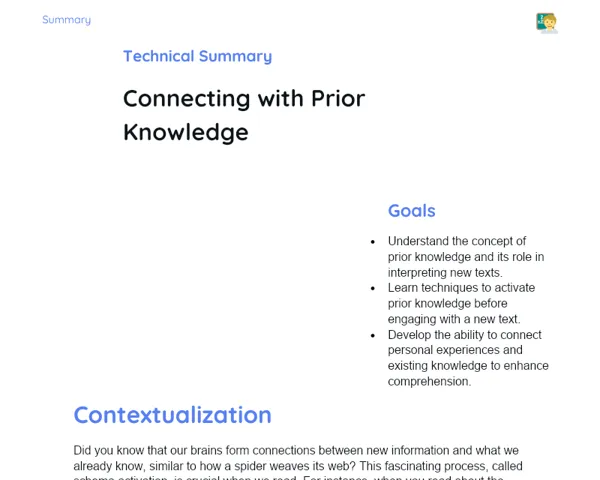Objectives
1. Describe objects seen in pictures using simple English phrases.
2. Identify activities depicted in images and explain them in English.
3. Enhance vocabulary related to everyday objects and actions.
Contextualization
Imagine you're in a bustling market like Chandni Chowk or a serene park in your neighbourhood, filled with vibrant colours and exciting scenes. Every picture tells a story – from the ripe fruits on a vendor's cart to children playing cricket in the sun. By learning to describe these images, you can bring the world around you to life with your words. Whether it's a family gathering or a festival celebration, your ability to talk about what you see will help you connect and share your experiences with others. Let's embark on this fun journey of exploration and expression!
Important Topics
Observing Details
Observing details in a picture means paying close attention to what you see. It's about noticing small things that make a big difference! For instance, in an image of a park, look for the colour of the flowers, the type of birds, or the way children are playing. This helps you form a clearer picture in your mind and allows you to describe it better. The more details you observe, the more vividly you can share the story behind that picture with others!
-
- Importance of Details: Details make your descriptions lively and interesting. Instead of saying 'There are trees,' you could say 'There are tall, green trees with bright yellow flowers.' This paints a much clearer picture!
-
- Engaging the Audience: When you include details, your listener imagines the scene better, making your conversation lively. For example, saying 'The little boy is laughing while flying a red kite' invites your listener into that joyful moment.
-
- Building Vocabulary: Observing details helps you learn new words. You'll find yourself using terms like 'gigantic,' 'sparkling,' or 'shimmering,' which add depth to your descriptions.
Expressing Actions
Expressing actions seen in pictures involves describing what people or animals are doing in a scene. This is crucial because it brings the picture to life! For example, instead of just mentioning two people are in a picture, you can say 'The woman is dancing gracefully while the children are cheering.' Such descriptions create a more dynamic narration and help convey emotions and excitement.
-
- Action Words: Using action words (verbs) like 'jumping,' 'running,' and 'laughing' makes your sentences exciting. Remember, actions define the mood of a scene! If I say 'The dog is barking loudly,' it evokes a different feeling than 'The dog is sleeping peacefully.'
-
- Connecting with Emotions: By describing actions, you can express feelings. For instance, 'The girl is clapping with joy' shows happiness, while 'The man is frowning' indicates sadness. These emotional connections are essential for effective communication.
-
- Creating Context: Describing actions gives context to your images. It helps others understand not just what is happening, but why it matters. Why is the group of friends laughing? Maybe they are sharing a funny story!
Descriptive Language
Descriptive language is about using words that describe the qualities of objects and actions. This includes adjectives and adverbs, which help create a picture in the listener's mind. For instance, saying 'The bright yellow flower is blooming in the sunny park' offers a more vibrant depiction than just 'There is a flower in the park.' This type of language is essential for effective communication in English, as it encourages you to use your creativity and imagination.
-
- Enhancing Clarity: Descriptive words make your message clearer. Instead of saying 'It's a bird,' you could say 'It's a small, cheerful bluebird singing on a branch.' It provides a clearer image and engages your listener's imagination.
-
- Stimulating Imagination: When you use colourful language, it encourages your listener to imagine the scene vividly. This makes conversations more enjoyable and memorable. For example, describing a market as 'bustling with aromas and vibrant colours' invites them to visualize that experience.
-
- Developing Writing Skills: Mastering descriptive language is crucial for writing too! When you learn to describe well, you can write stories, poems, and essays that captivate your readers.
Key Terms
-
Observation: The action of closely examining something to gain specific insights or details.
-
Descriptive Language: The use of adjectives and adverbs to enhance the meaning of nouns and verbs, making descriptions more vivid.
-
Action Verbs: Words that express physical or mental actions, crucial for conveying dynamic scenes.
-
Adjectives: Words that describe nouns, giving details about size, shape, colour, etc.
-
Adverbs: Words that modify verbs, adjectives, or other adverbs, providing more context about how actions are performed.
For Reflection
-
- Why do you think observing details in a picture is important for storytelling? Reflect on an experience where details changed your understanding of an event.
-
- How do you feel when someone describes a scene in a captivating way? What kind of words would you use to describe your room or your favourite place?
-
- In what ways can descriptive language influence the way we perceive everyday situations? Consider how your words might impact someone's understanding of a simple event like a family dinner.
Important Conclusions
-
Describing pictures helps us bring our surroundings to life, making conversations more exciting and relatable.
-
Observing details enhances our descriptive language, allowing us to paint vivid images with our words.
-
Understanding actions depicted in pictures creates emotional connections, making communication more impactful.
To Exercise Knowledge
Take a picture of your favourite spot at home or in your neighbourhood. Write a short paragraph describing what you see, focusing on details, actions, and using descriptive language. Share it with your family and encourage them to guess your favourite place!
Challenge
Choose a picture from a magazine or online that interests you. Describe it in three sentences, using at least two action verbs and three adjectives. Challenge your friends to guess what the picture is about based on your description!
Study Tips
-
Practice describing everyday scenes around you, like markets or parks. The more you practice, the easier it becomes!
-
Create a vocabulary list of new adjectives and action verbs you come across. Use them in your daily conversations!
-
Watch cartoons or listen to stories in English. Pay attention to how characters describe their surroundings and actions, and try to imitate that style in your descriptions.


